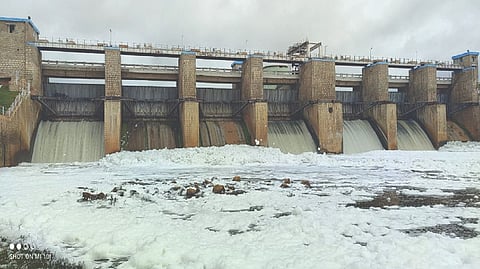

COIMBATORE: It has become a rather usual phenomenon for ‘Thenpennai’ River or South Pennar River that flows into Kelavarapalli dam in Krishnagiri to turn foamy, whenever it is in spate following rains.
Effluents discharged by industries in Karnataka are blamed to be the reason for high pollution in the river. However, a solution to the issue that is haunting people for years seems nowhere in sight.
“It is not only during rains, but the river brings effluents released by industries in Bangalore all through the year. A request has been made to the Karnataka government to set up Sewerage Treatment Plants (STP) and let only treated water in the river. Our demand has hardly evoked any response,” said Hosur DMK MLA Y Prakash.
Further, Prakash said the state government has proposed to establish treatment plants in lakes to process this water to be used for irrigation purposes. “At the entry point into Tamil Nadu from Karnataka, the river remains highly toxic, where even fish could not live, but gets naturally purified to a certain extent as it flows down.
The Pollution Control Board officials tested the water to confirm pollution and the National Green Tribunal (NGT) has already seized the matter,” he said. Despite such heavy pollution, the farmers in the district have a different perspective on the issue as they claim that this water is rich in nutrients that boost crop growth.
KM Rama Gounder, state president of Tamilaga Vivasayigal Sangam, said, “The water was tested for its quality and found to be rich in nutrients essential for crops. It is sans any poisonous chemical components as only treated water is discharged into the river in Karnataka. Foaming could be due to the presence of sulphur, which is inseparable and necessary to maintain good soil health. It helps to melt down salt content in the soil and aid crop growth.”
To further validate his claim, Rama Gounder said in 1950’s many farmers cultivated only ‘black paddy’ due to the high salt content in the soil. “Our lands turned fertile after irrigating with this water. Gradually, most of the farmers switched over to cultivating high-yielding regular white paddy varieties in the last 20 years and the area of cultivation grew by over one lakh acres in the district. Even fertilizer usage has come down due to the presence of nutrients in this water,” he said.
Curiously, there is hardly any strong voice of protest against the pollution in the river due to opposition from farmers. “Several years ago, political parties used to stage protests almost daily alleging discharge of effluents into the South Pennar River. They however became silent after we farmers announced counter protests them,” said farmers.
Visit news.dtnext.in to explore our interactive epaper!
Download the DT Next app for more exciting features!
Click here for iOS
Click here for Android